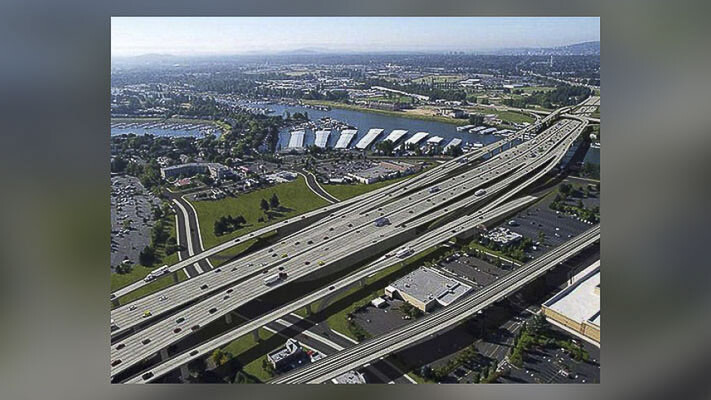The updated study will also include a summary of other low-income tolling programs across the nation

Timothy Schumann
The Center Square Washington
Do toll lanes primarily benefit wealthy motorists? That was a question that a professor of transportation wrestled with in a recent presentation to the Washington State Transportation Commission.
The presentation was titled “Toll Equity on [Washington State Department of Transportation] Toll Facilities.” Professor Mark Hallenbeck, director of the Washington State Transportation Center at the University of Washington, laid out the vision for tolling equity in Washington state.
Hallenbeck does statistical research with expertise in “urban transportation planning and policy, electronic traffic monitoring, tolls, and traffic simulations,” according to his profile page on the University of Washington website.
His answer as to whom toll lanes benefit could be summed up by that old Facebook relationship status: it’s complicated.
“The argument is that they’re ‘Lexus Lanes,’ that only rich people use them,” Hallenbeck told The Center Square via phone. “What we have shown is that’s not the case, though rich people do use them more often”
The findings are from a 2019 study through the UW’s “Data Science for Social Good” program, also helmed by Hallenbeck.
That study found that higher income households use the toll lanes more frequently on a per-household basis, but lower income households account for the bulk of tolled traffic, and derive more economic benefit on a per trip basis than higher income households.
“It’s fair that only the people who use the facility pay for it. But sometimes these things are expensive, and that means low income people can’t use them, and that’s not fair nor equitable,” said Hallenbeck.
Because pricing of the I-405 toll lanes changes based on traffic levels, you can see that as the toll price increases from $2.50 up to the state legislated maximum of $10.00, the median yearly income of those using the toll lanes drops from $130k to $62k.
This may seem counter-intuitive, but it’s just an example of Professor Hallenbeck’s 2019 study findings, that “lower income households derive more economic benefit on a per trip basis.” As the traffic congestion and thus price of the toll increases, lower income households become a higher percentage of total toll lane occupants.
The rest of the presentation was preliminary numbers from Hallenbeck’s current project, an ongoing study funded by the Washington State Transportation Commission that was delayed due to funding issues caused by the COVID-19 pandemic.
“I should have retired in April of 2020 having solved traffic congestion,” joked Hallenbeck, before adding, “The problem was no money, nobody was using the tolls. Only this last June did we get the resources necessary to take the next steps.”
Those next steps, and the ongoing project’s goals, are to update numbers from the I-405 study in 2018, and pull in every other toll road in the state using current July 2021 to June 2022 data.
This means covering all five tolling facilities for the state, including I-405, SR99, SR167, SR520, and SR16, better known as the Tacoma Narrows bridge.
Hallenbeck said the previous study on just I-405 included some 27 million data points. The current study, which is an extension of that, will include significantly more.
Aside from additional tolling data from WSDOT, it uses much more modern data collection and correlation techniques such as buying third party cell phone location data from brokers.
Asked if there were any plans to use the data to adjust toll pricing, Hallenbeck replied in the negative saying, “They’re more interested in the change in equity in the low income demographic.”
Hallenbeck explained the purpose of the study isn’t adjusting toll pricing, it is to equitably “maximize the value in the [toll] lane without degrading the performance.”
To that end, the updated study will also include a summary of other low-income tolling programs across the nation including samples from California, Colorado, Illinois, and Virginia.
The question then will be, “Is it economically worthwhile to implement such a program in the Evergreen state?”
“We just want good information to get into the hands of the decision makers,” said Hallenbeck, noting that WSDOT, WSTC, and the Legislature will all have access to the data from his new study due to be completed by the end of June 2023.
This report was first published by The Center Square Washington.
Also read:
- Opinion: Neighbors for a Better Crossing calls for a current seismic study for $7.5 Billion Interstate Bridge projectNeighbors for a Better Crossing is urging a new seismic study before construction proceeds on the $7.5 billion IBR project, raising transparency concerns and proposing an immersed tube tunnel alternative.
- Rep. John Ley supports C-TRAN Bus Rapid Transit to save Washington moneyRep. John Ley praised C-TRAN’s new BRT line as a faster, lower-cost alternative to light rail, urging support for transit options that save taxpayers money and improve service.
- C-TRAN, WSU Vancouver celebrates groundbreaking for The Vine on Highway 99C-TRAN and WSU Vancouver broke ground on the Vine’s Highway 99 route, a 9-mile bus rapid transit line connecting the university to downtown Vancouver and the Waterfront, set to open in 2027.
- C-TRAN board again postpones vote on light rail operations and maintenance costsThe C-TRAN board again postponed a vote on language regarding operations and maintenance costs tied to light rail expansion, with pending lawsuits involving Michelle Belkot continuing to impact board actions.
- Opinion: ‘The Interstate Bridge project lacks billions in funding from both Oregon and Washington’Lars Larson criticizes Oregon’s funding decisions, highlighting the billions missing from both states for the Interstate Bridge replacement project and calling it a dead-end effort lacking Coast Guard approval.









